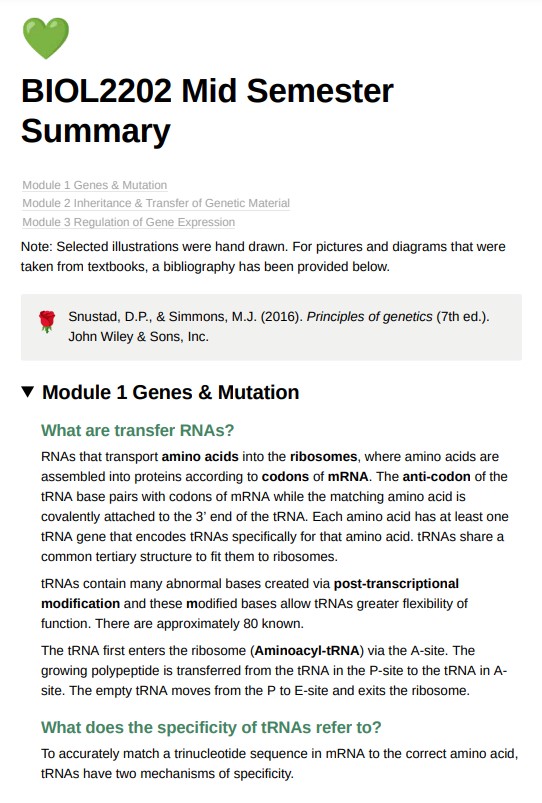Biology Notes About Genetics
Summary:
The Biology Notes About Genetics provides comprehensive coverage of the MICR2000 course code, “Microbiology & Immunology,” offered at The University of Queensland. It covers the entire semester and includes 9 modules, which are Introduction to Microorganisms, Microbial Growth, Bacterial Pathogenesis, Virology, Environmental Microbiology, Mycology, Immunology, Vaccines and Viral Diagnostics, and Parasitology. Additionally, the note includes detailed explanations and illustrations for all the modules, which are separated into key concepts.
Excerpt:
Biology Notes About Genetics
Module 1 Genes & Mutation
What are transfer RNAs?
RNAs transport amino acids into the ribosomes, where amino acids are assembled into proteins according to codons of mRNA. The anti-codon of the tRNA base pairs with codons of mRNA while the matching amino acid is
covalently attached to the 3’ end of the tRNA. Each amino acid has at least one tRNA gene that encodes tRNAs specifically for that amino acid. tRNAs share a common tertiary structure to fit them to ribosomes.
tRNAs contain many abnormal bases created via post-transcriptional modification and these modified bases allow tRNAs greater flexibility of function. There are approximately 80 known.
The tRNA first enters the ribosome (Aminoacyl-tRNA) via the A-site. The growing polypeptide is transferred from the tRNA in the P-site to the tRNA in Asite. The empty tRNA moves from the P to E-site and exits the ribosome.
What does the specificity of tRNAs refer to?
To accurately match a trinucleotide sequence in mRNA to the correct amino acid,
tRNAs have two mechanisms of specificity.
1. Aminoacyl-tRNA synthetase specificity: Identity elements in the acceptor stem specifies the correct amino acid to be added. Each tRNA only carries one specific amino acid.
2. Codon specificity: Codon-Anticodon interaction specifies when this tRNA is needed during translation. The correct codons must be recognized for the amino acid.
Threonyl-tRNA synthetase complex: There are 20 (one for each amino acid) and each interacts with a different part of the tRNA. They search for empty tRNA and reload them with the specific amino acid.


Reviews